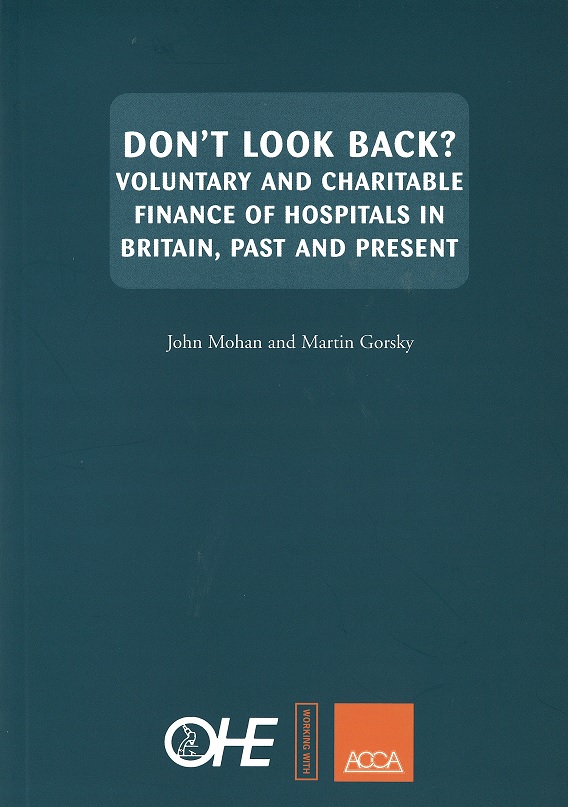Sign up to our newsletter Subscribe
Challenges and Solutions for Budget Impact Analysis of Gene Therapies

This book provides a reassessment of the role of charitable and voluntary fundraising for health care, with a particular focus on the hospital. It does so firstly by summarising the principal findings of a major research project on the pre-National Health Service (NHS)…
This book provides a reassessment of the role of charitable and voluntary fundraising for health care, with a particular focus on the hospital. It does so firstly by summarising the principal findings of a major research project on the pre-National Health Service (NHS) voluntary hospitals. Independent of the state and funded initially by charitable gifts, these hospitals cared for the acute sick before 1948 and were the centres of research and teaching. We discuss their performance, and that of the voluntary system, in its last decades. Secondly we explore contemporary trends in charitable fundraising, examining its extent and impact. The key elements of the book are the following:
1. A review of proposals for a greater role for the voluntary sector in the provision of welfare services. Discussion of this issue has emanated from several positions on the political spectrum, and ranges from a desire to roll back the frontiers of the state, to a concern to revive participation in the institutions of civil society.
2. A reassessment of the record of voluntary hospital provision before the NHS, and of the role of charity since 1948. The findings are organised around four central themes:
● Charitable finance: Although the inter-war years were a time of expansion, this was also the period in which the funding of voluntary hospitals was transformed. Traditional philanthropy proved insufficient and gave way to private payment and a shift to mass contributory arrangements. However, the late 1930s saw financial crisis looming, as current account deficits multiplied and the asset base of many institutions was eroded. The revival of charity in the 1990s has posed a rather different problem: the unpredictability of charitable finance (rather than its inadequacy, since charity is not being relied upon to provide core services).
● Provision and utilisation: The spontaneous and localist aspects of voluntary action led to the uneven development of hospital provision. The result was that well before the ‘postcode rationing’ identified with the NHS access to care was inequitable, since it was shaped by residence. Under the NHS it has been large urban hospitals, particularly those with a glamorous national and international reputation, that have attracted the bulk of charitable funds. The tendency for charity to enhance regional variations and hence inequities has therefore persisted. The pattern of charitable endowments and income remains dominated by a very limited number of institutions, mainly located in London.
● Co-ordination and planning: Improvements in the quality and availability of hospital care depended on collaboration and partnership, both with the public sector and with other voluntary institutions. However, the traditional independence of the voluntary hospitals impeded this process and despite some promising initiatives in particular localities there was still no co-ordinated hospital system by 1939. In recent years the revival of charitable giving has proven to be inimical to planning. The local enthusiasms underpinning voluntary support for individual institutions can conflict with proposals to rationalise provision in order to achieve wider regional or national strategic objectives.
● Democracy and participation: Openness, subscriber democracy and accountability were attributes of the voluntary hospital from its inception, though participation was initially limited to wealthy middle-class contributors. The transition to mass contribution in the early 20th century strengthened popular support for the institutions, though leadership remained in the hands of traditional elites. There are some parallels here with the situation under the NHS. Although community support of health services is widely encouraged, NHS services are largely run by organisations which have little direct input from those who make considerable commitments to raise money for their local facilities.
3. A concluding assessment of the extent to which the issues posed by the uneven development of charity remain with us today, as a consequence of the recent expansion of charitable fundraising. The parallels are not exact but are nonetheless instructive. We end with a review of some potential policy options for striking a balance between charitable provision and social need.
Don’t Look Back? Voluntary and Charitable Finance of Hospitals
Mohan, J. and Gorsky, M.
(2001) Don’t Look Back? Voluntary and Charitable Finance of Hospitals. OHE Monograph. Available from https://www.ohe.org/publications/dont-look-back-voluntary-and-charitable-finance-hospitals/